Today, the aircraft carrier is the most powerful warship afloat, a vessel that dominates the ocean's surface and can project power far inland. But it was not always this way, and the aircraft carrier has evolved greatly over the last century.
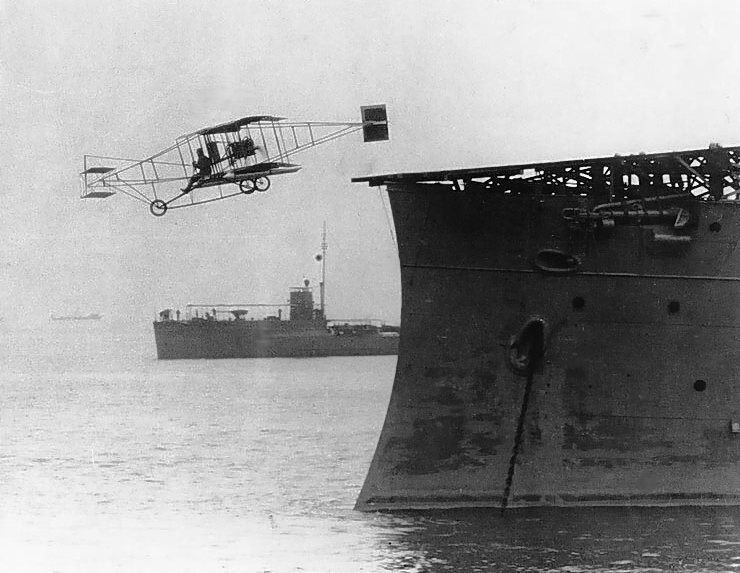
The first takeoff from a ship
The first man to take off from and land on a ship was an American pilot by the name of Eugene Ely. In November 1910, Ely took off from a ramp on the cruiser USS Birmingham, and flew ashore. Two months later, he landed on a platform built onto the cruiser Pennsylvania. In both cases, the ships were at anchor. While the first takeoff from a moving ship took place the next year, the first landing proved elusive.
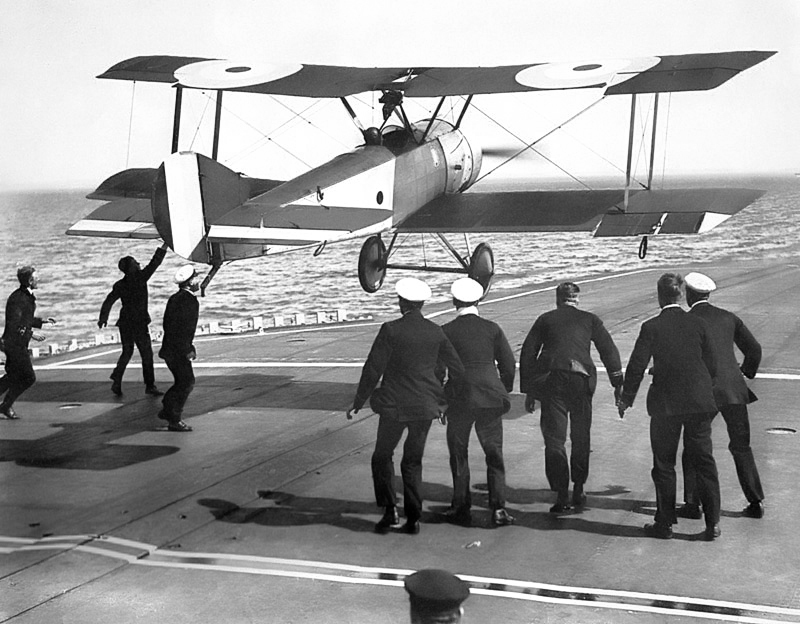
Dunning landing on Furious
The problem was that a ship in motion tends to leave a wake of turbulent air, which was seriously problematic for the light aircraft of the time. The first landing, by Edwin Dunning, took place in 1917 on the forward flying-off deck of the converted battlecruiser Furious. He flew alongside the ship, then sideslipped over the deck and landed essentially vertically, as the stall speed of his Sopwith Pup was lower than the combined speed of Furious and the wind she was steaming into. Tragically, Dunning was killed five days later attempting to repeat his feat.
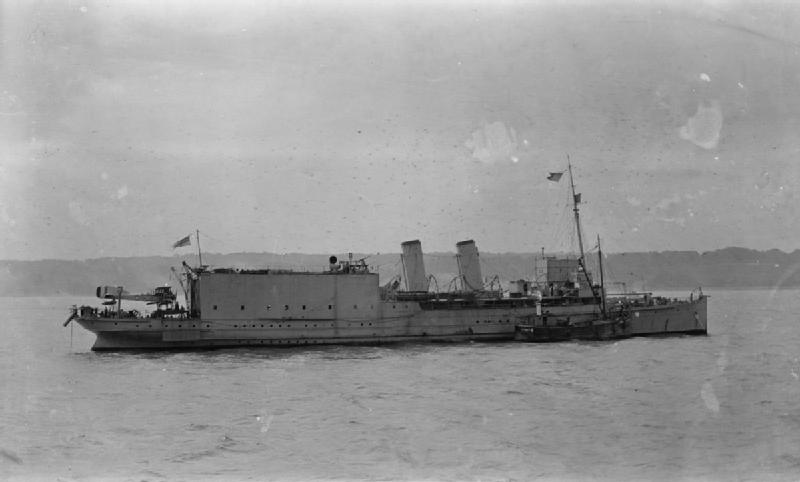
HMS Engadine
But while there was early interest in flying off of ships, the first airplanes to go to sea operationally were seaplanes, which took off from and landed on the water. This meant that it was much easier to carry and operate them, and the British converted many cross-channel steamers and other merchant ships to seaplane tenders during WWI. One of these, HMS Engadine, flew sorties during the Battle of Jutland, the first use of heavier-than-air scouting during a naval battle.
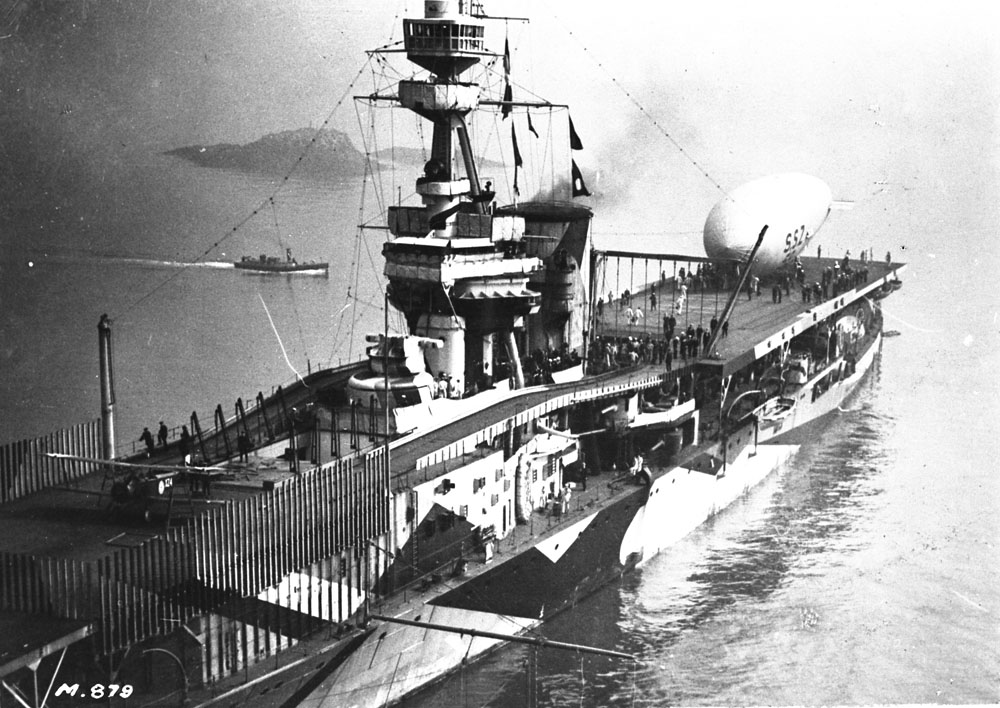
Furious with both flying-off and landing decks1
But seaplanes were hindered by the weight and drag of their floats, and could only take off if the weather was right. The solution was to build flying-off ramps on the seaplane carriers, and simply ditch the aircraft at the end of the flight.2 Soon, flying-off platforms were added to many of the battleships and cruisers. The battlecruiser Furious was completed with her forward turret replaced with a flying-off platform to allow aircraft to be taken with the fleet. Furious was later modified with a landing-on platform aft, but the intact superstructure meant that landing was incredibly dangerous.
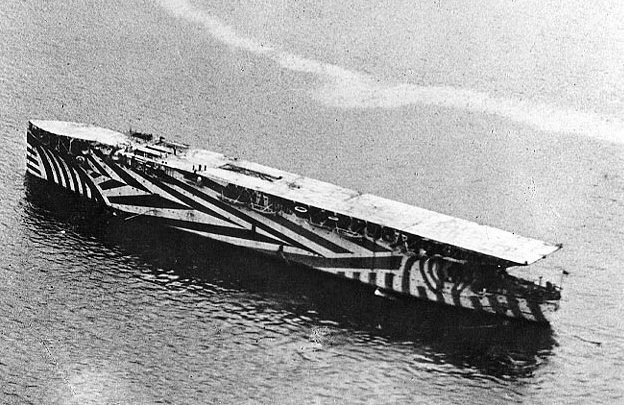
HMS Argus
The first real carrier, HMS Argus, was commissioned in September 1918. She had a completely flush deck, removing the problems of turbulence, and a hangar under it to allow the aircraft to be stored out of the weather. There was also primitive arresting gear consisting of wires running lengthwise down the deck and snagged by hooks on the airplane was fitted, although this proved difficult in service and the RN abandoned it entirely in the 20s. A better solution, running the wires across the decks, was perfected by the Americans and only adopted by the British in the mid-30s. Several other carriers followed Argus into British service, some with superstructures on the starboard side, where it was discovered they would not throw too much turbulence across the landing area.

Akagi, one of the few carriers to have an island on the port side
By the time of the Washington Naval Treaty, the aircraft carrier was definitely established as part of the fleet, and carriers were given a special category separate from battleships. One clause allowed the US and Japan to convert two capital ships each that would otherwise have been cancelled under the treaty to carriers. The resulting ships, Lexington, Saratoga, Akagi and Kaga, were the first carriers built that were big and fast enough to be still in first-line service when World War II broke out.
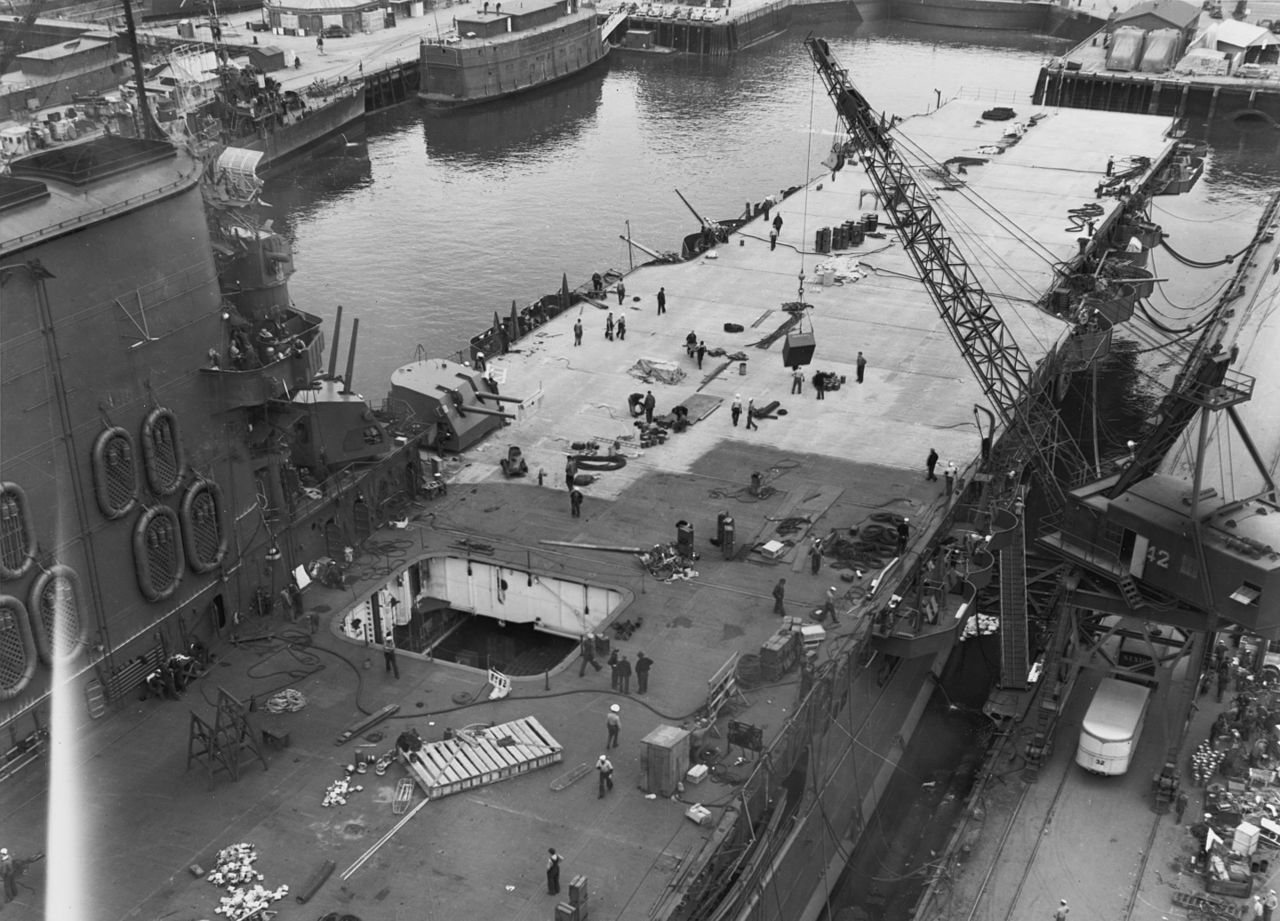
The aft section of Saratoga's flight deck, showing the arrestor wires
Aviation advanced rapidly during the interwar years, with wood-and-fabric biplanes giving way to metal monoplanes. Initially, carriers were seen as valuable mostly for scouting, providing planes to spot gunfire and shooting down enemy planes doing the same. There was also interest in strike missions against small ships, or to disable and slow battleships. The wilder claims of Billy Mitchell and his ilk, who believed the battleship to be obsolete, were largely ignored. But by the late 30s, the situation had changed, as aircraft were faster, longer-ranged, and capable of carrying serious loads of weapons.3
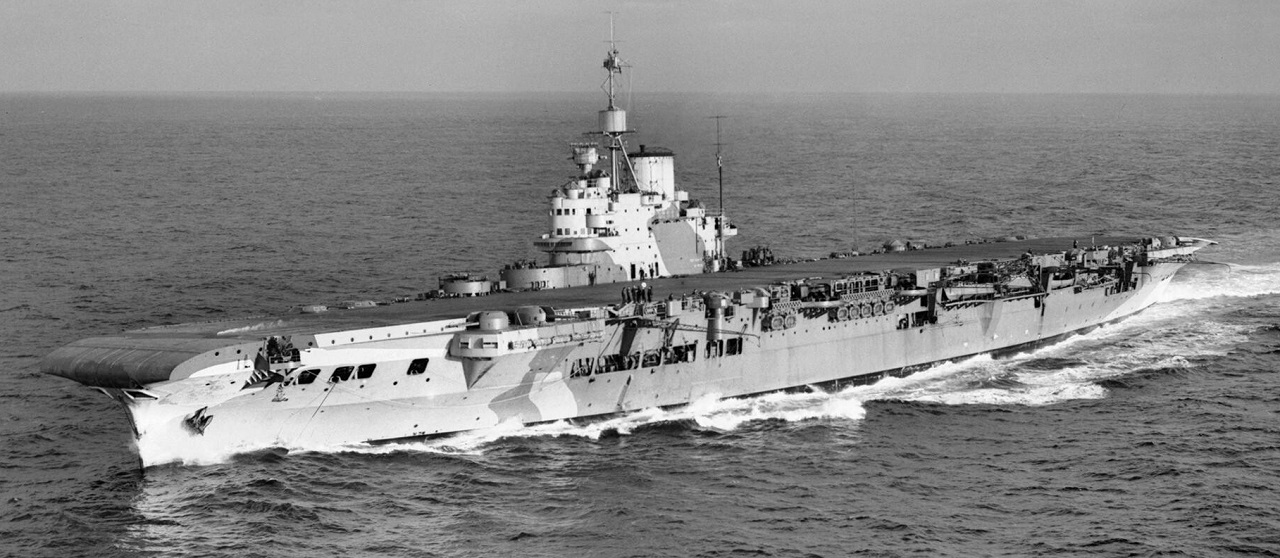
Armored-deck carrier HMS Victorious
This led to a new generation of carriers built in the mid to late 30s. These ships, typified by the American Yorktown class, were about 20,000 tons, smaller than the conversions, but capable of carrying almost as many aircraft at a speed of around 30 kts. A typical wing was between 70 and 90 planes, a mix of fighters, scout/dive bombers, and torpedo bombers. Many of these planes were kept parked on deck, and had to be moved around as the carrier shifted from launch to recovery. The British, concerned about the threat of air attack in the Mediterranean and believing that there was no way to provide an effective defense using fighters, built armored carriers instead and planned to keep all of their planes down in the hangar. While this made some sense in 1935, the reductions in airwing capacity as a result of the armor turned out to be a serious problem during the war, as the advent of radar meant that fighters became viable again.
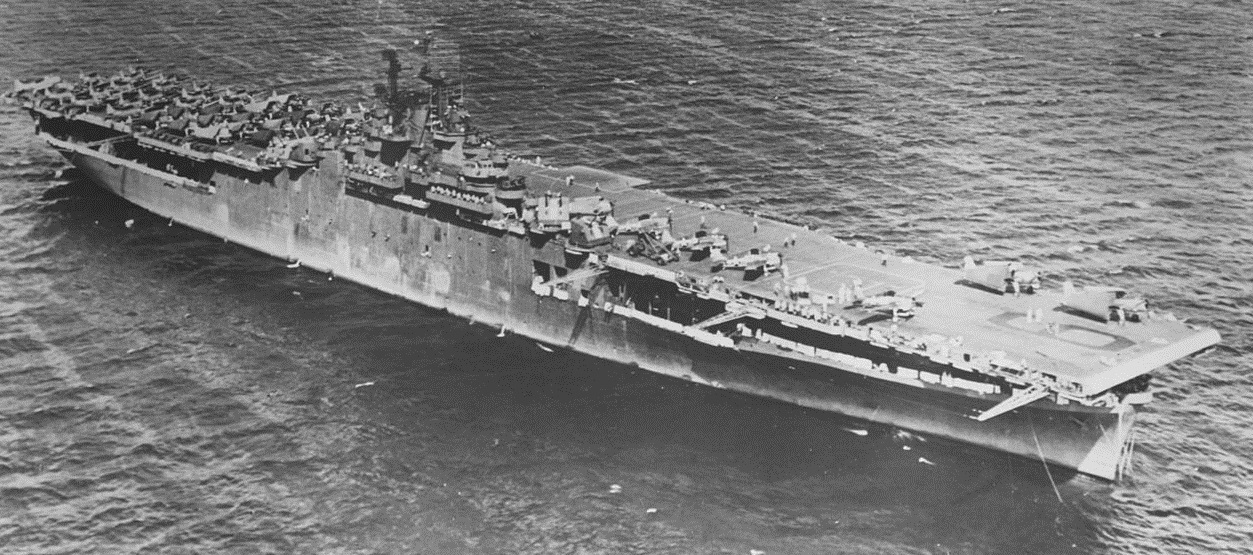
Essex in 1944. Note the deck-edge elevator on the port side.
World War II was when the carrier really came into its own. It dominated the Pacific War, from Pearl Harbor to Midway and the Philippine Sea, and gave valuable service in the Atlantic. The most prominent carrier to come out of the war was the American Essex class, 24 of which were completed. They were about half again as large as the Yorktowns, and proved to be superb ships, the last one staying in service until 1991.

Light Fleet Carrier HMCS Warrior
World War II also saw the development of several specialized types of carrier. All three major carrier powers found themselves short of fleet carriers during the early years of the war, and ordered the development or conversion of light carriers, essentially smaller stripped-down versions of the fleet carriers. The British Light Fleet Carriers in particular turned out to be one of the most successful carrier designs ever, serving in eight different navies worldwide. The last ship derived from this design was not retired until 2017.
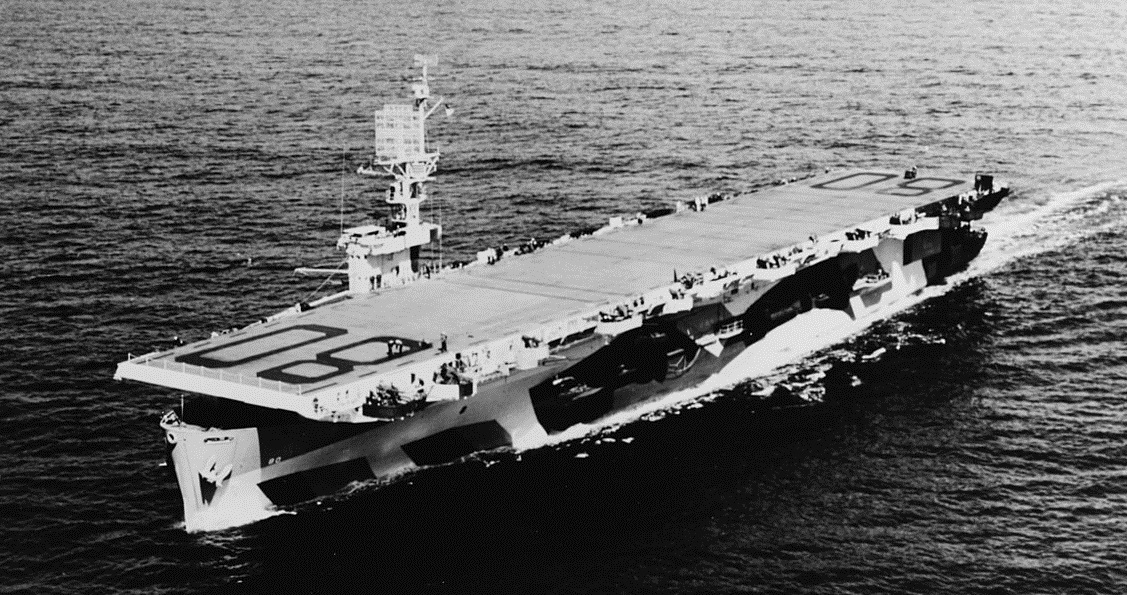
Escort carrier Petrof Bay
The other major carrier type to come out of the war was the escort carrier or CVE. This was a much more rudimentary ship than the light carrier, as it was originally intended to provide anti-submarine air cover to convoys of merchant ships in the Atlantic. The result was a smaller vessel capable of only about 18 kts, and with an air group of about 24 planes. Besides hunting submarines, escort carriers covered amphibious landings and served as aircraft transports. Postwar, most saw little use, their roles being largely replaced by helicopters. Escort carriers did make an important contribution in the development of catapults. Normally, aircraft carriers provided enough wind over the deck for their airplanes by steaming at full speed into the wind. The low speeds and short decks of the CVEs meant that catapults were used to provide the extra speed.4
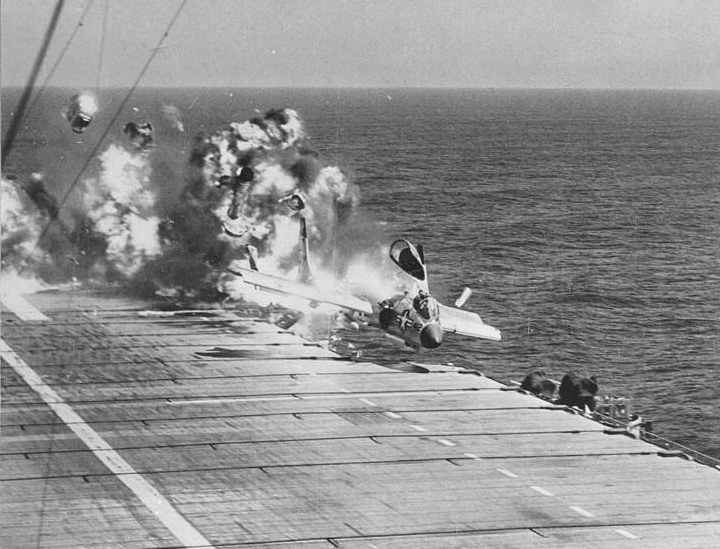
An F7U Cutlass crashes aboard USS Hancock
This became important at the end of World War II, when jets began to enter service. Initially, there was serious concern if jets could even operate from carriers, due to their greater weight, higher stall speeds and poor throttle response. Catapult launches became the norm, but the early years of jet operations were incredibly dangerous. The huge numbers of WWII-surplus carriers meant that few new ships were built, and the existing ships had to be extensively modified. The carrier also came under attack in the immediate postwar years from advocates of land-based airpower, who claimed that nuclear-armed bombers made them obsolete, a claim the US Navy successfully rebutted.
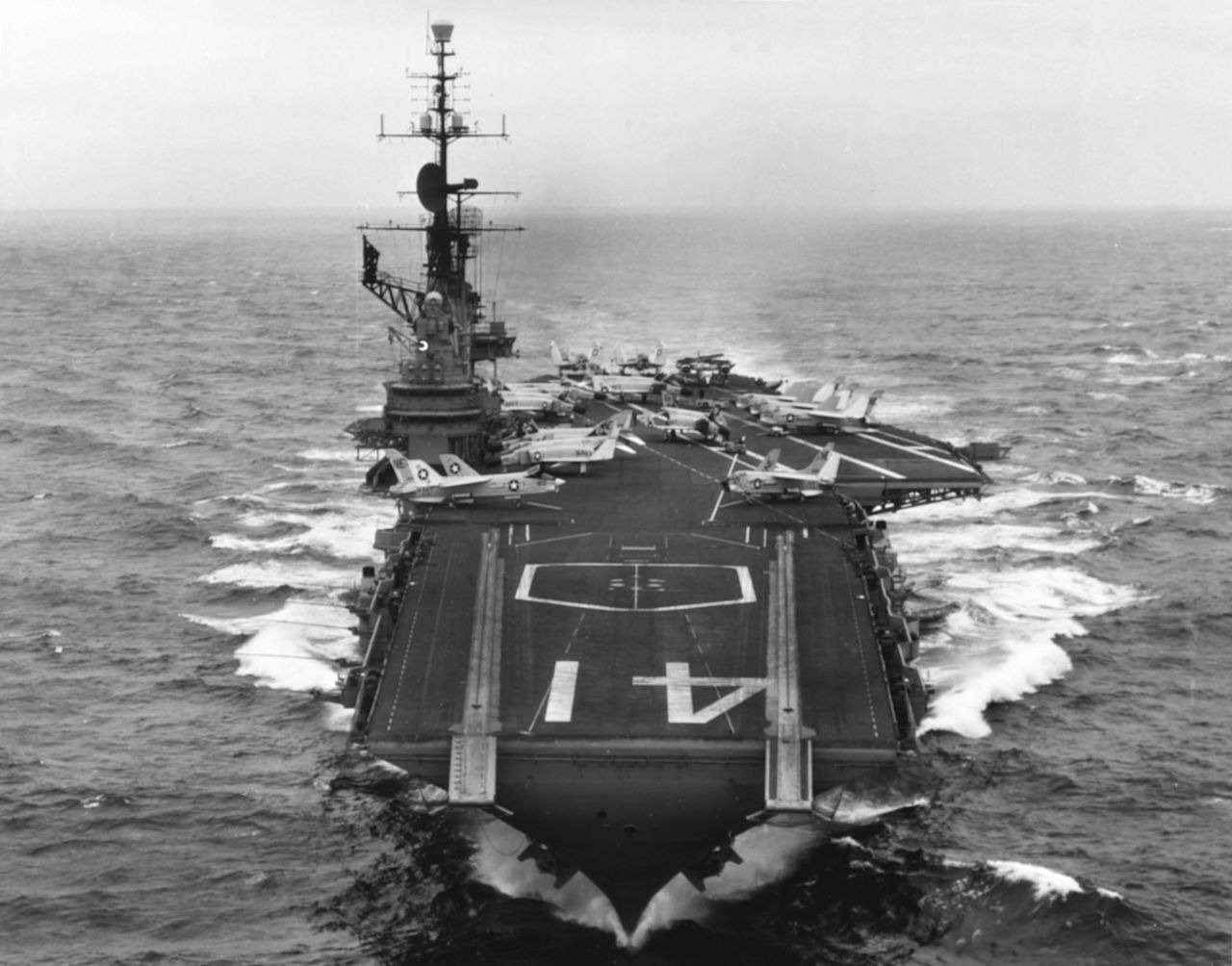
Midway, successor to the Essex, showing the long tracks of steam catapults and the angled deck
The British came to the rescue with three inventions which made jet operations safe and routine. The first was the steam catapult, capable of launching heavier planes safely.5 The second was the angled deck. The landing area was slanted 10-15 degrees off the ship's centerline, which meant that a plane which failed to snag the arrestor wires could now go around instead of running into the crash barrier set up to protect the planes parked forward. Aircraft could be launched and recovered at the same time, although it became more common to simply park planes on the deck out of the way during recovery. The third was the mirror landing system, which allowed pilots to set up their approach at a greater distance than had been possible under the previous manual system, where a man on deck guided them down. All three systems remain in use today with only minor modifications.
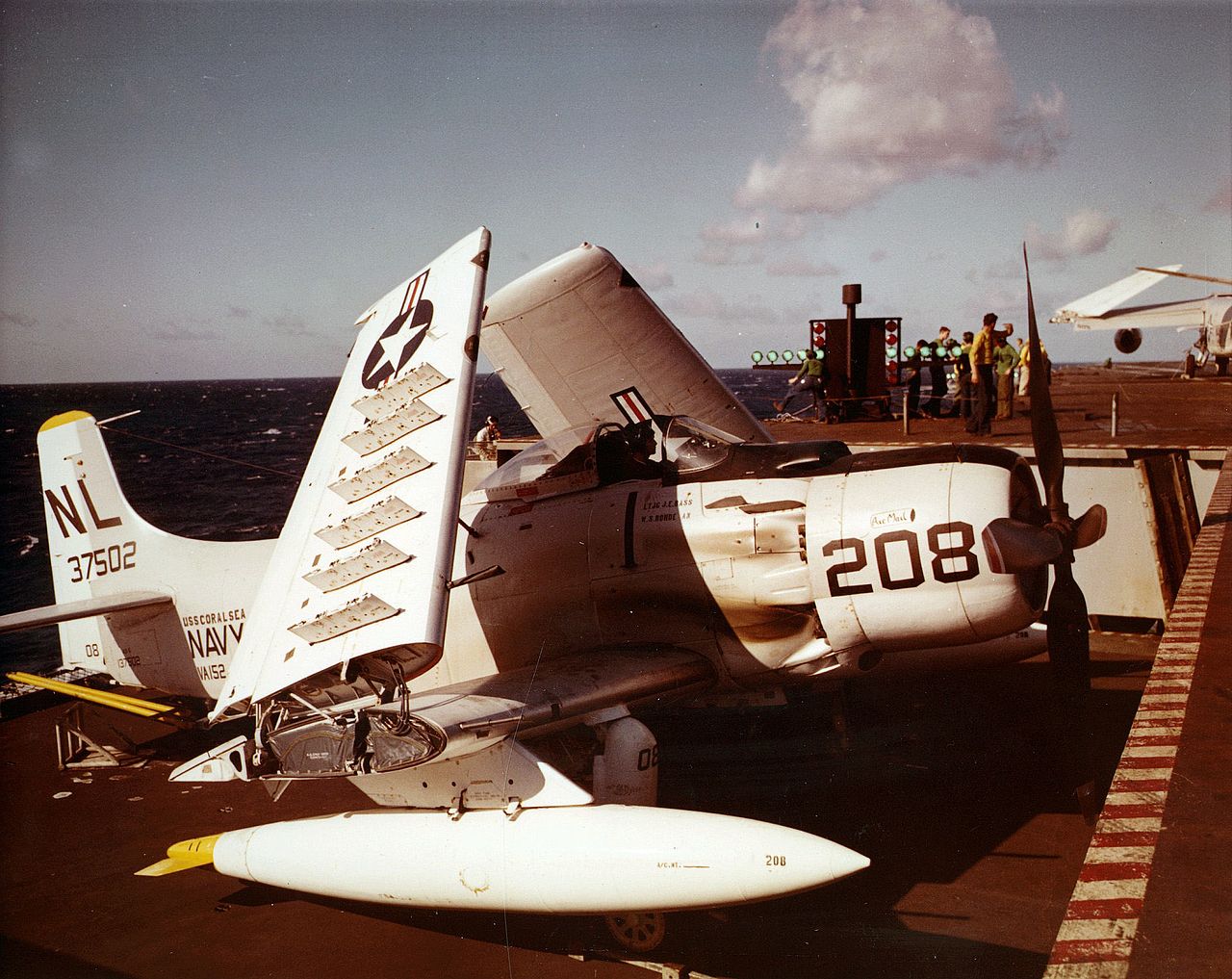
A-1H Skyraider on the USS Coral Sea, with mirror landing system behind
During the early 1950s, the US Navy moved into the nuclear strike role, which would take bigger carriers to operate the new aircraft. The resulting ships, known as "supercarriers", are the largest warships ever built, capable of carrying about 90 jets and operating them in combat. The first of this type, the Forrestals, were about 80,000 tons fully loaded. Another leap came in the late 50s, when the nuclear-powered USS Enterprise was built. Nuclear power meant that Big E could maintain high speed indefinitely, and freed up space for more aviation fuel and ordnance.
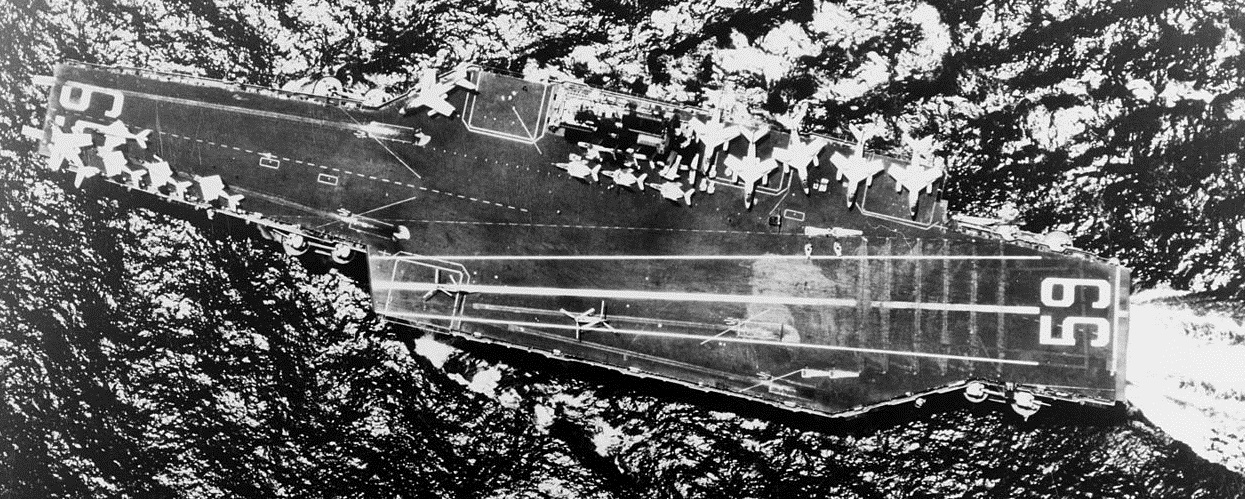
A view of the deck of Forrestal. Note the angled deck, arrestor wires, elevators, and port catapults firing over the elevator. This elevator was moved aft in later ships.
The 50s and 60s also showed another role for the carrier, providing air power during limited wars like Korea and Vietnam. The carrier, capable of going anywhere there was salt water and independent of most diplomatic constraints, quickly became a chosen instrument of American power. The dinosaur-burning supercarriers were followed in the 70s by the nuclear-powered Nimitz class, which form the backbone of the USN today.
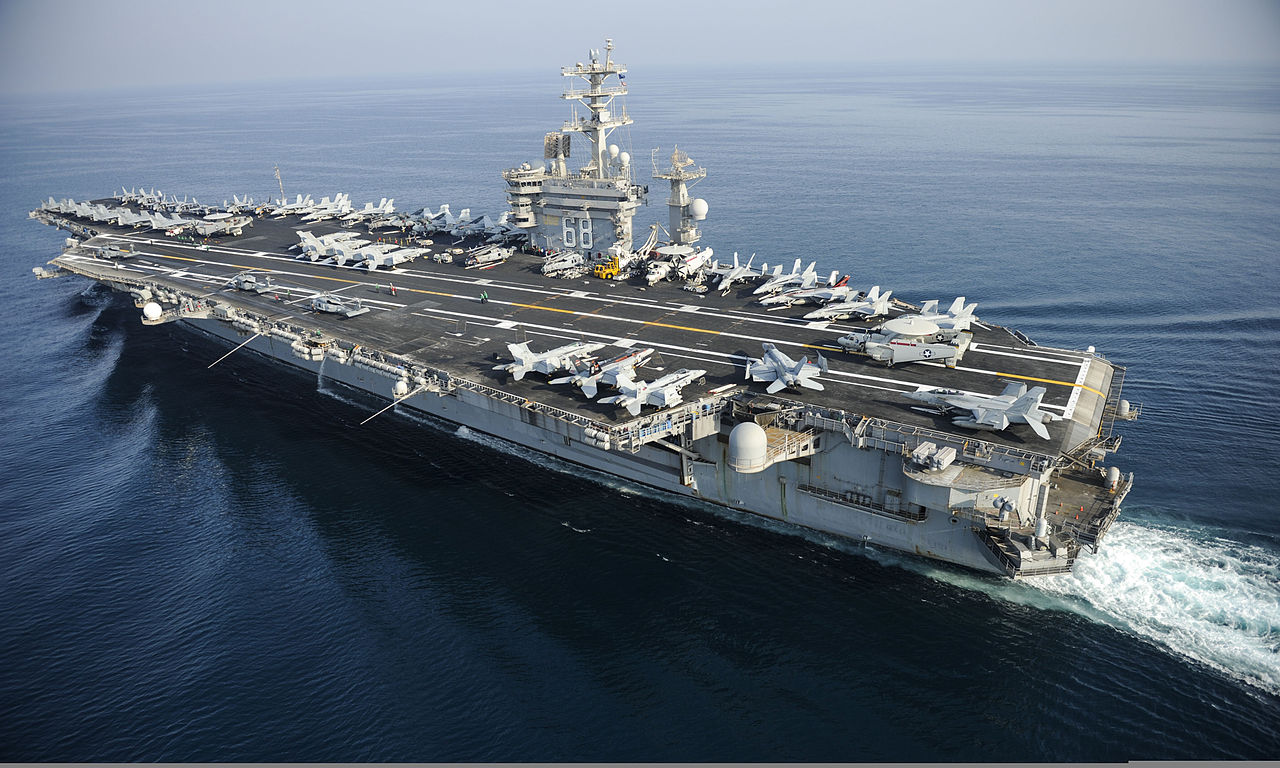
USS Nimitz
On the other side of the Atlantic, Britain decided in the early 70s to abandon its conventional carrier force, and instead found itself relying on the Harrier, an airplane capable of taking off and landing vertically. Many nations built ships like the Invincible class to keep some seaborne aviation capability without having to pay for the massive carriers necessary to operate conventional airplanes. It was soon realized that a rolling takeoff would increase the load a Harrier could carry, and ski-jumps were fitted to many of these carriers to increase payload even more. Ultimately, the Harrier played a key role in the British victory in the Falklands.
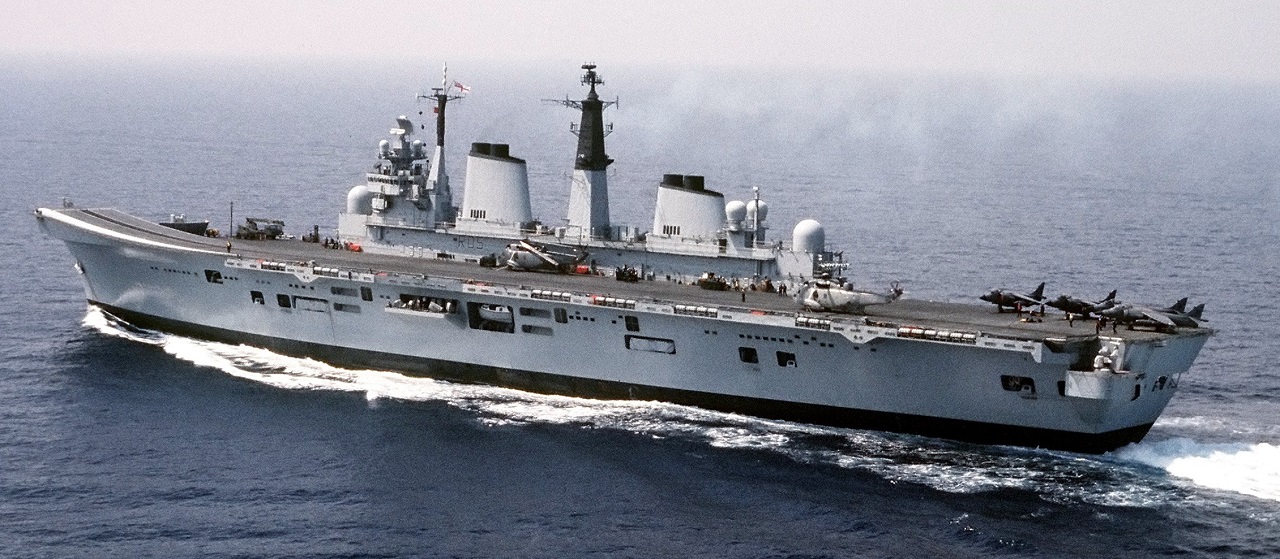
Invincible with Harriers on deck
Russia also joined the carrier game, although in a way different from typical Western practice. Their first carriers used STOVL6 aircraft similar to the Harrier, but their only true carrier, the Kuznetsov, takes advantage of the high thrust-to-weight ratio of modern fighters to dispense with the catapult. Instead, it uses a ski-jump to get its wing airborne, then recovers them using arrestor wires. This allows a smaller, cheaper ship at the cost of reduced payload and an inability to launch slow fixed-wing aircraft for roles such as airborne early warning and sea surveillance.
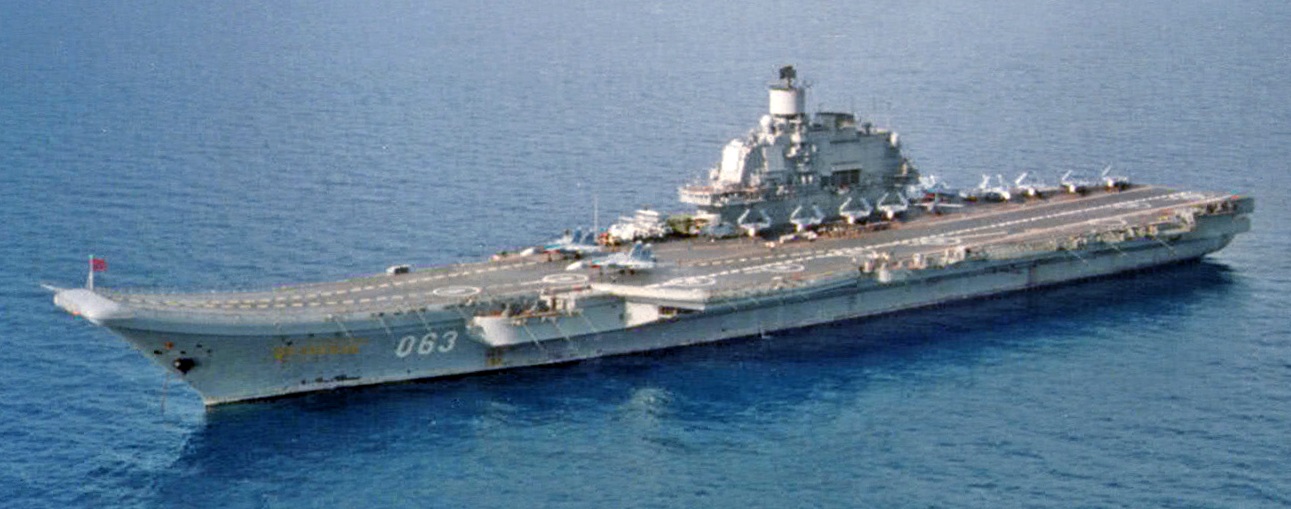
Kuznetsov
Today, we stand on the brink of the greatest change in carrier aviation in half a century. The F-35 is taking stealth to sea, while the new Ford-class carriers have introduced electromagnetic catapults and an improved flight deck to make it easier to generate sorties using modern guided weapons. The British have recently commissioned their first supercarrier, the Queen Elizabeth. She recently completed her first deployment with the STOVL F-35B, which gives her capability unmatched outside the USN.
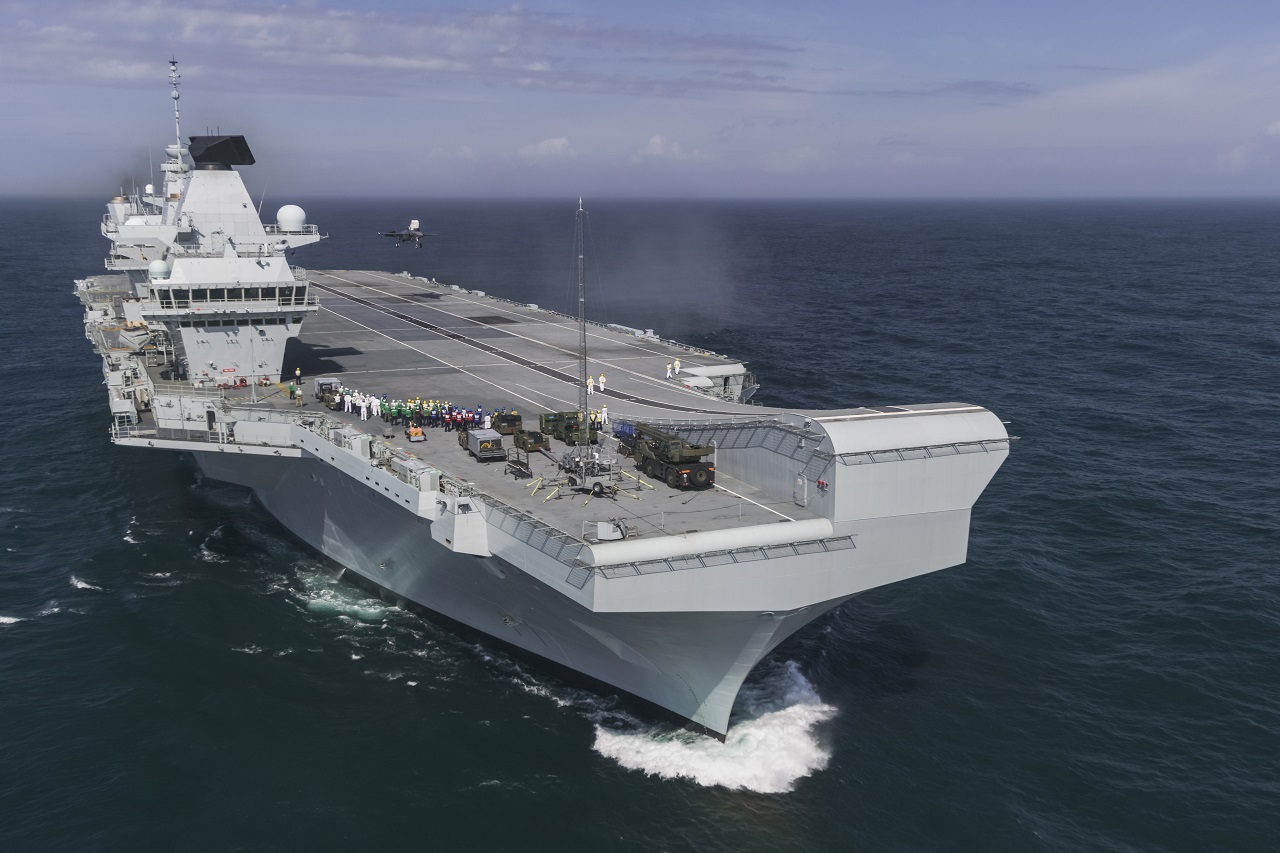
An F-35B making its first landing aboard Queen Elizabeth
In the century since its inception, the aircraft carrier has gone from a minor participant in the war at sea to the most powerful and flexible instrument naval warfare has ever seen. Today, the few countries that can afford them treasure their carriers for their ability to provide rapid airpower anywhere they can float.
1 The flying-off deck extends quite a ways to the left of the photo. ⇑
2 While this sounds very strange, at the time, aircraft were incredibly cheap. The plane would only be launched for specific missions, usually to attack zeppelins or occasionally shore targets. ⇑
3 To put some numbers on this, let's compare the Sopwith Camel, used from Furious at the end of the war for raids ashore, with the Blackburn Skua, the standard British carrier fighter at the start of the war. The Skua could fly twice as fast and twice as far, and carry five times the bombload. And the Skua was essentially a failure, while the Camel was one of the best fighters of its day. ⇑
4 Catapults had been fitted to fleet carriers since the 30s, but they were rarely used because they significantly slowed the launch cycle, being reserved for when there wasn't enough wind or the deck was full. CVEs were the first to make regular use of them. ⇑
5 Previous catapults had mostly been hydraulic, and had essentially reached the limits of possible development. ⇑
6 Short Take-Off and Vertical Landing. ⇑

Comments
Also, the Japanese "Helicopter destroyers". Their F-35B's will absolutely fly from those. Not that they'd ever start calling them carriers.
Japan hasn't ordered any F-35Bs, although that may change. Italy has, but their ships are a lot smaller, and not really set up for strike operations the way the QEs. (Turkey is apparently looking at buying them, too, although I have no idea why.)
Sorry for double post, but I mean seriously. This doesn't look like a carrier at all:
https://upload.wikimedia.org/wikipedia/commons/thumb/1/1d/DDH-181%E3%81%B2%E3%82%85%E3%81%86%E3%81%8C%2812%29.jpg/1200px-DDH-181%E3%81%B2%E3%82%85%E3%81%86%E3%81%8C%2812%29.jpg
And neither does this:
https://en.wikipedia.org/wiki/File:DDH-183%E3%81%84%E3%81%9A%E3%82%82(5).jpg
And the fact that they have estimated flight deck space for ~20 aircraft on each of the Hyugas, and ~30 on each of the Izumos, and their current air groups are 4 and 7 helicopters per ship isn't suggestive of anything at all.
Although I gotta give it to them, it takes some chutzpah to call a 27000 ton ship a destroyer.
Sorry for that, direct linking to the images is broken in some way, probably unicode issues. Here are the wikipedia articles I took them from:
Izumo Hyuga
How are the electromagnetic catapults doing? Last I heard is that there were some serious teething problems.
Yeah, that did change, just last week.
Japan Set to Procure F-35B STOVL Aircraft for JMSDF Izumo-class 'helicopter destroyer'
While it is possible the Hyugas were built with the F-35B in mind, I think it's more likely they were intended to be used as amphibious assault ships, and the extra space was planned for staging air assault forces.
@Tuna-Fish
There's a couple of things going on here. First, Japanese translation is hard, and I believe the word usually rendered in English as destroyer is more like "escort ship". That's how Google Translate renders it. In fact, they're officially just "escort ships", like everything else in the JMSDF. (I'm going to double-check this, but it could be a few days.) Second, there are potential issues with Article 9 of the Japanese constitution, which renounces war and offensive armed forces. Aircraft carriers are generally believed to be covered by this prohibition. Third, not all ships with flat tops are the same. I don't know enough about the internal arrangements of those ships to be sure if they're capable of usefully operating F-35s or if that capability would be "fly a few strikes for PR purposes, then go find an ammunition ship" like it would be if you loaded a US LHD/LHA with F-35s or Harriers.
@midwestBill
EMLAS hasn't had the smoothest of births, but teething problems happen. I suspect they'll get the kinks worked out. They usually do.
@Jez
Wiki article hasn't been updated to reflect that yet, then. I'm not surprised at this, and we can definitely use stronger allies in the Far East.
@Chuck
I think that's part of it, although it's not mutually exclusive with allowing them to fly F-35s. The Queen Elizabeths have a secondary LPH capability, too.
And I should also point out that the wartime helicopter groups are likely to be a lot larger. You traditionally need about 8 choppers to keep 2 in the air at all times, and they might want more than 2. It's hard to blame them for wanting lots of ASW capability, given what our submarines did to them.
Is there any particular reason QE doesn't have arrestor gear? I guess I can kind of see catapults as being expensive and hard to implement, but arrestor wires seem pretty simple and cheap, and would allow aircraft to land with heavier loads.
Is there any ability to retrofit catapults to QE? She seems like an awfully big and expensive ship to be limited to the F-35B and ONLY the F-35B, at least for fixed-wing aviation.
Two things:
Why did they put the island on the starboard side, rather than port? That seems the convention for all the carriers, so I’m sure once the first one did that the rest did, but do you have any insight into why the first one did that?
I know SSBNs aren’t really that powerful in the same way that carriers are, being essentially mobile missile silos than traditional offensive weapons, but they seem like the true contenders for most powerful members of the Navy? Anyways, I’d love if you could eventually give us an article or two on them?
Because the F-35B doesn't have a hook. The structural modifications required to refit one would be expensive and heavy, and while you might get a slight increase in recovery weight, you're going to lose payload, which is the last thing you need on a STOVL fighter.
There's no ability to refit catapults. It was promised early on, but when they looked in 2012, it was estimated to cost about 2 billion pounds for Prince of Wales alone. The refit cost on Queen Elizabeth after completion would have been even more. I think this was a bad call, although I've seen disagreement from people who I respect.
@RedRover
I believe it had to do with the rotary engines used on WWI-era aircraft. Turning right pushed the nose down, while a left turn raised it. So the island went on the starboard side, where it wouldn’t be in the way if you had to go around. The Japanese built a couple of ships with islands on the port side, under the idea of operating them with right-hand patterns next to ships with left-hand patterns. It didn't seem to be successful.
I’ll get there eventually. Carriers are definitely the most powerful in non-nuclear warfare, and I was writing a bit for rhetorical effect. I do plan to do more of these “brief history” posts, but there’s a lot of other stuff I want to do, too.
So does this mean that early ship-launched seaplanes were more akin to cruise missiles than aircraft? Single-use planes launched to attack a particular threat and then abandoned thereafter?
I suppose it does, although those were landplanes, not seaplanes. (I know they were operating from seaplane carriers. I didn't make up this terminology.)
I was under the impression that they were supposed to be designed to be re-fitable with catapults. They never will be, of course, because once you've bought a bunch of F-35Bs and AW101s you aren't going to sell them all and buy F-35Cs and E-2s in addition to the cost of catapults, but from at least 2010-2012 the QEs were going to have catapults. They reversed that decision only when EMALS ran into development troubles.
@Tuna-Fish
They aren't carriers, and if Japan tries to use them as such they're going to end up very disappointed in the results. fast jets consume fuel and munitions at much higher rates than ASW helicopters, and I'd be shocked if the Izumos had the storage or elevator capacity to make serious use of that capacity. They'd be trading excellent ASW platforms for mediocre strike platforms.
That's not what David Hobbs says in his British Aircraft Carriers. He stated that EMALS and the arresting gear itself would have cost about 500 million pounds, only a quarter of the total cost of getting it on PoW. Apparently, the builders did a truly horrible job of planning for catapult inclusion.
@bean
If it were anyone other than BAE, I might have trouble believe that they could fail at something so fundamental.
My thoughts exactly. I know that it's much easier to not do the work on things like that, but I'm still surprised they got away with ignoring a design requirement like that. Of course, it's BAE.